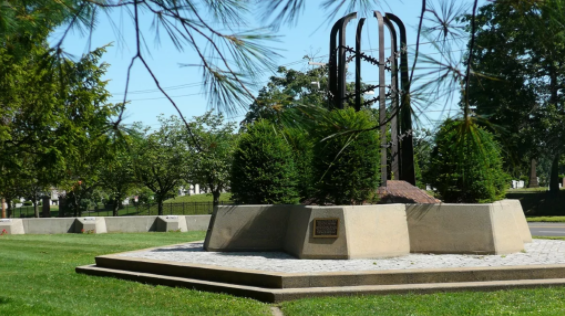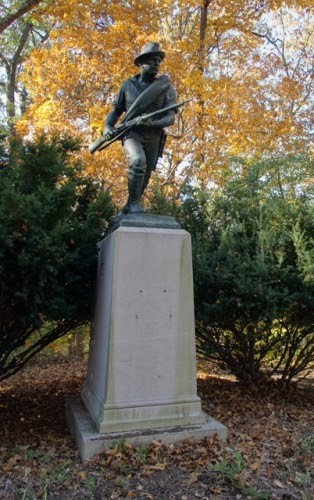The Holocaust Memorial of New Haven
By Emily Lange
You’re sitting at the stop sign on West Park Avenue in New Haven ready to turn right onto Whalley Avenue. You look over to your left and see a structure with a sort of barrier around it. What is it? It’s the Holocaust Memorial that is dedicated to the six million Jews that were brutally murdered as part of the Nazi's Final Solution during World War Two. It is for us to remember and grieve this loss. This memorial is thus a constant reminder of the tragedy that happened in hopes that something similar never again occurs.
While you might just see a structure when you look at it, there is so much more to the memorial than may originally meet the eye. Originally, the design was supposed to only be six small trees in the shape of the Star of David. However, architect Augustus Franzoni, who was not Jewish, wanted to donate his time and skill to make a more extensive memorial, which is the one we see today. The trees are still there on each corner of the Star of David, which is made from cement. Underneath the center of the memorial is an urn filled with ashes from one of the camps, Auschwitz. The sculpture in the center of the Star of David consists of six bars wrapped in what looks to be barbed wire which is supposed to represent what the entrance of the camps looked like. There are 1800 stones around the sculpture; also, there are eighteen markers around the whole thing that have names of Nazi death camps. Eighteen is an important number in Judaism because it is called “chai” which means both eighteen and life. That is why multiples of eighteen were involved in the creation of the memorial.
This memorial was unveiled, in a sense, in 1977 which is about thirty-two years after World War II ended. We might wonder why it took so long to create one, but part of that reason is that survivors that had moved to New Haven had just settled down with their families. The survivors, headed by Lew Lehrer, and Mayor Frank Logue were very interested in creating a memorial. Once they knew they could create this memorial, they went to work on funding and creating a committee. One of the survivors, Shifra Zamkov, went door to door in order to ask people for donations to help fund the memorial. One donation they received that helped very much was the eighteen hundred stones, which you walk on as you enter the memorial and they also surround the outside of the Star of David. These were procured freely when New York City's West Side Highway was being redone.
While some monuments are forgotten or fall into disrepair, this monument remains extraordinarily relevant to the community. It is a place where people can go to grieve, learn, and just think about this tragic historical moment. People can grieve about the ones they have lost and about how it has affected their society. People can come to learn about what has happened because many do not know much about this horrendous genocide. The memorial is truly a place to learn about everything that happened and everyone that was affected in order to be able to reflect upon the past; there are events where people come to the memorial to remember and learn about the Holocaust. For example, one of the children of a survivor said that the architect that built this, Franzoni, did not know much about the Holocaust; before he came up with the design, the mayor and the survivors had to explain it to him. People also come to think about how this event has affected our world today and the people around us. It is not forgotten, especially in New Haven where some people might pass it every day.
This memorial isn’t just important in New Haven, but in the United States. It was one of the first Holocaust memorials that was built by the direction of a city government. There was an article written about it in The New York Times, indicating that it received national attention at the time of its unveiling. The article talked about the dedication of the memorial. It described what the memorial looked like, who spoke, some things that were spoken about, and the events leading up to the creation of the memorial. When the Holocaust happened, many people did not know about it or what happened. Today, almost everyone knows what happened. With the help of this memorial, it shows how the country has changed and has come to see what happened to the Jews, which should not and will not be forgotten.
 |
| Courtesy of “People Forget, New Haven Remembers”: A good look at the different parts of the memorial and its surroundings. |
 |
| Courtesy of the Jewish Historical Society of Greater New Haven: An image of some of people that gathered at the Holocaust Memorial dedication in 1977. |
Bibliography
Herman, Barry E. Jews in New Haven, Volume II, The Jewish Historical Society of New Haven, 1979.
Hegel, Richard. “Veterans and War memorials and Monuments in the City of New Haven, Connecticut.” Journal of the New Haven Colony Historical Society: 36.
Macaluso, Laura A. The Public Artscape of New Haven: Themes in the Creation of a City Image. Jefferson, NC: McFarland & Company, Inc., Publishers, 2018.
Pelland, Dave. “Holocaust Memorial, New Haven.” CTMonuments.net, March 15, 2010. http://ctmonuments.net/2010/03/holocaust-memorial-new-haven/
“People Forget, New Haven Remembers,” directed by Elena Neuman Lefkowitz (2015; New Haven, CT: NeumanFILMS, 2015), Documentary.
The New Republic, December 21, 1942
The New York Times, October 30, 1977.



Comments
Post a Comment